Stay tuned for this detailed AdGuard VPN review to check how a VPN performs coming from a world-famous adblocker brand.
A Virtual Private Network (VPN) isn’t just for privacy and security. In fact, most users use it for entertainment, social media, and news. However, its importance in giving a safe and anonymous internet is something to reckon with.
On a very surface level, a VPN conceals your real IP address. This hides your actual location to some extent and lets you bypass regional firewalls. For instance, an efficient VPN should let you access Facebook from China. In addition, every VPN should encrypt your data so as to make public WiFi safe, primarily for financial transactions.
But there is a lot more to it you can find in our guide to virtual private networks.
Anyways, let’s stay focussed on the main subject of this article and start this AdGuard VPN review with some history.
Background
AdGuard Software Limited started in 2009 in Moscow, until 2014, when it moved to headquarters in the island country of Cyprus.
Apparently, its adblocker products were so good that they faced friction from the Google and Apple play stores. Google restricted it in 2014, though users could still download it from the company website, and Apple blocked AdGuard updates in 2018 only to allow them in 2019.
But AdGuard VPN only launched somewhere in 2020, with the first half of the year seeing the release of the Android beta version. And the first stable rollout of VPN for Windows was in October 2021, named AdGuard VPN 1.1.
More importantly, AdGuard calls VPN its “signature product” and “flesh-and-blood VPN”. In addition, they mentioned that this is their own independent development. So, we can presume this isn’t another white-label product.
While White labels VPNs aren’t necessarily bad, such products are manufactured for a general audience by the original developer, resulting in a bland experience and less than ideal support. So it’s always good if you’re directly purchasing it from the original developer.
Finally, AdGuard VPN has an excellent free plan with limited choice for server location but a very generous 13GB per month. Still, there are free and unlimited VPNs in the market, but most compromise on the performance, with some having glaring security loopholes.
So it’s actually good to have a defined limit, especially if you’re using a free VPN.
Coming to the features, the list does miss out on some of the very modern VPN aspects but still has everything a normal user might need:
- No-logging
- 52+ Server Locations
- Kill Switch
- Auto Start
- Split Tunnelling
- Website Safelisting
- 5 Simultaneous Connections
- Custom DNS
- Socks5 Proxy
- Subnet Exclusions
- 30-day Money Back on Annual Subscriptions
It would have been great had AdGuard bundled its adblocker with its VPN implementation. In addition, features like Tor over VPN, double VPN, malware, and phishing protections were absent.
AdGuard VPN has native clients for Windows, Mac, iOS, and Android. In addition, there are browser extensions for Chrome, Firefox, and Edge. At present, Adguard VPN has no application for implementation on WiFi routers.
Privacy
AdGuard VPN privacy policy assures no-data logging. However, they collect the data usage information with the session lengths.
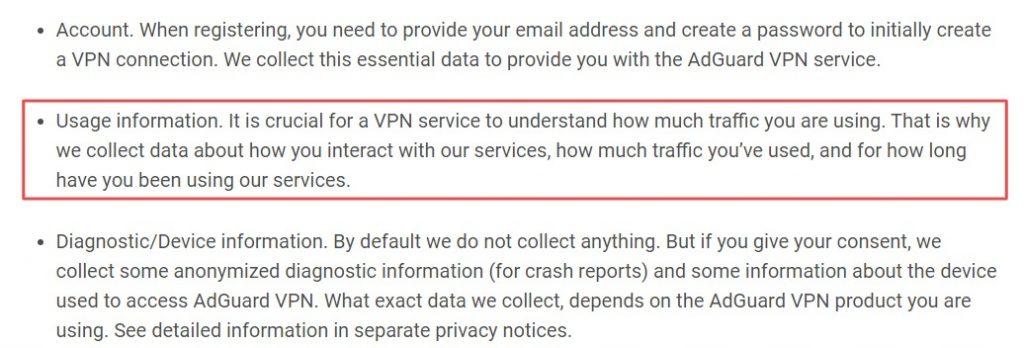
You must know even the top-of-the-line VPNs with unlimited data subscriptions collect information about aggregate data usage.
Personally, it isn’t a deal-breaker for me. But if you care so much for anonymity try using MullVad VPN.
They don’t even require your email address during registration. You interact and use the service based on a random number assigned to you at signup. Additionally, you can pay them in cash and cryptocurrency–the most privacy you can ask for from any VPN company.
Encryption
AdGuard VPN doesn’t use any in-practice VPN protocols. Instead, they have come up with their own AdGuard VPN protocol. They use HTTPS (TLS) for encryption and HTTP/2 as the transport protocol so that it gets harder to detect if you’re using a VPN at all.
They argued the quicker network speeds led them to use this and stay away from the conventional options.
That can be good considering it’s a custom development that should perform robustly with their own VPN application.
On the downside, while well-known VPN protocols like OpenVPN have stood the test of time, AdGuard VPN Protocol is pretty new. Moreover, this isn’t open source. So, there can be unknown vulnerabilities waiting for exploitation.
Finally, a few more options could have been much more user-friendly. So forcing all their users (free and paid) to their untested, closed-source, brand new VPN protocol is a very bold move from AdGuard that can cost them a substantial amount of users that can simply opt for their well-established rivals.
Just so you know, AdGuard VPN protocol has plans to go open source, and it will be interesting to see if their implementation has any loopholes.
Anyways. Let’s check this VPN hands-on to see what’s under the hood.
Adguard VPN Review
First, download the AdGuard VPN, install it, and signup within the app to get started.
You can register with an email address in addition to Google, Apple, and Facebook logins. Ideally, create a separate email address with an encrypted email service like Proton mail and use it here if you’re here for a long haul.
Afterward, you start with a really simple user dashboard with an ample amount of white space.
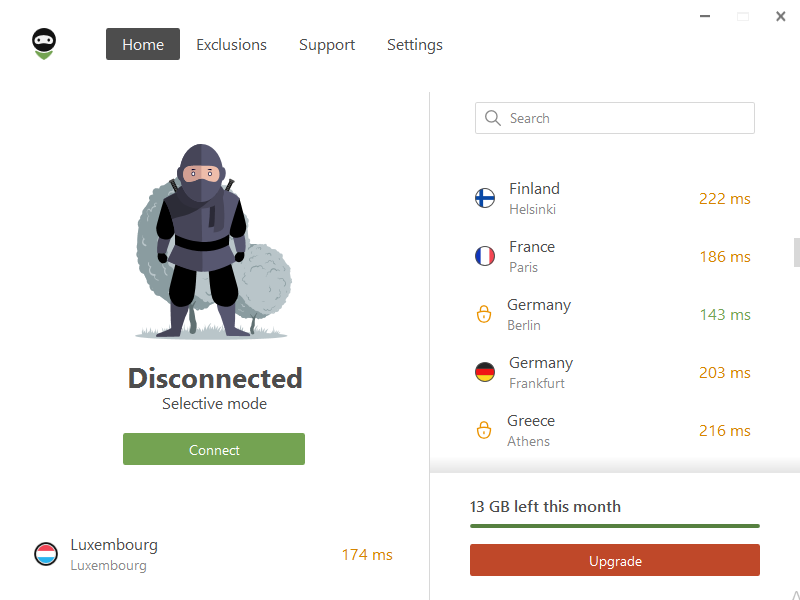
The right panel is mostly a tease unless you’re a paying customer. The server locations without a lock icon are open to the free users. As of this writing, there were 13 free locations, which are decent considering again the free data you get.
Connections were really fast, with connecting to VPN servers within spilt seconds of the click.
Kill Switch
Kill Switch blocks the internet access in case a VPN connection drops. It’s an industry-standard feature to protect your internet protocol address in case of any technical hiccup.

You can find these features in Settings > General > Kill Switch.
However, with AdGuard VPN, this works only if there is a server-side issue and grants internet access if you haven’t connected to it, deliberately or otherwise.
For instance, some VPN providers block the internet unless the VPN is connected. Yet, AdGuard’s kill switch is not that advanced and doesn’t cover a user who has simply forgotten to connect.
Split Tunnelling
Split tunneling is the selective use of a VPN connection. The objective can be to save on the bandwidth for non-privacy-intensive tasks or enjoy normal (and generally faster) connection speed elsewhere.

As stated in the image, the added applications will work normally without the encryption and the speed throttling that comes attached with it.
A similar feature is Website Safelisting. It lets you further enforce connection filtering based on the web address.
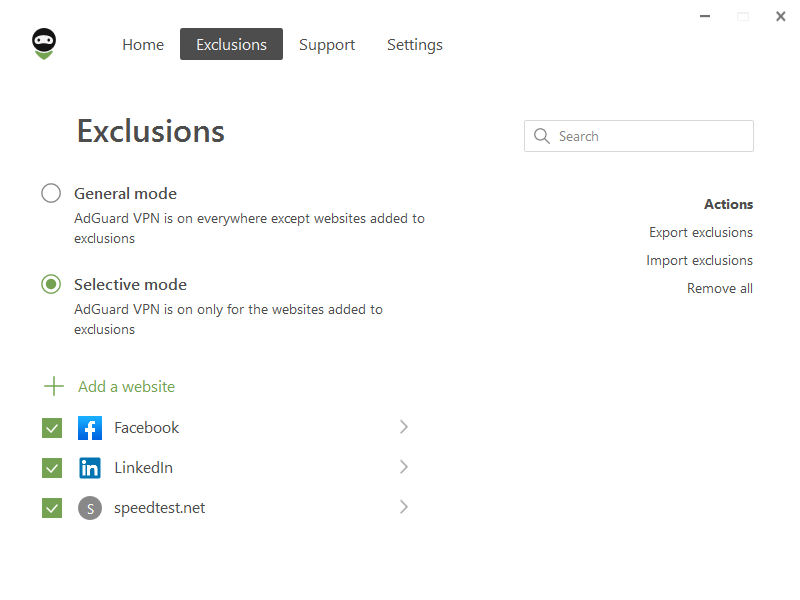
This is similar to split tunneling the only difference is that it works on the website level and not with the individual applications
The +Add a website opens a pop-up to manually enter the URL, or you can select from the given list.
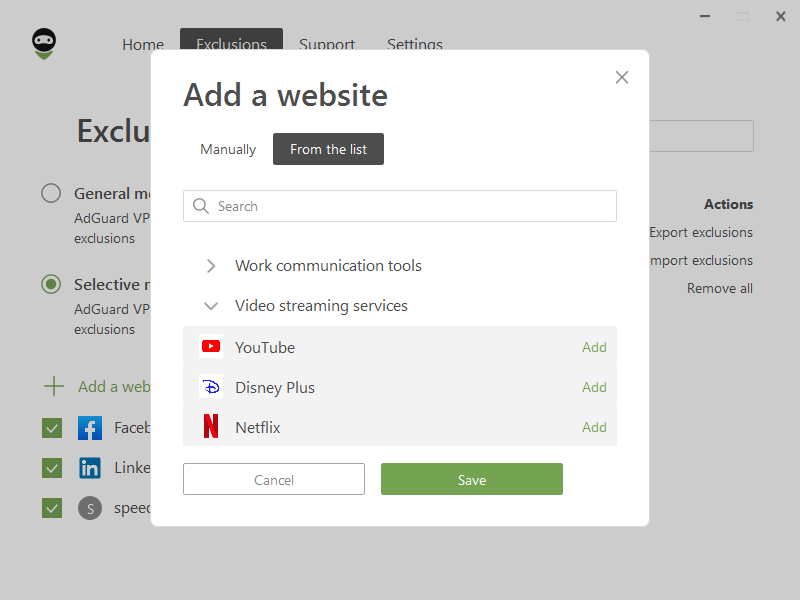
Alternatively, you can use the option listed on the right under Actions—Import exclusions.
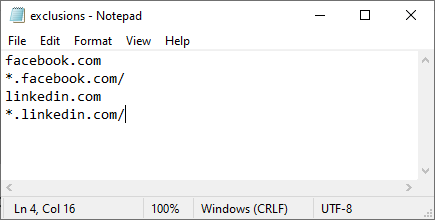
Make a text file having the list of websites in the shown format and upload it. This is particularly useful for bulk exclusions, another attempt to save the VPN bandwidth.
A yet another but more advanced feature sitting under Settings > General > Advanced Settings is Subnet exclusions.
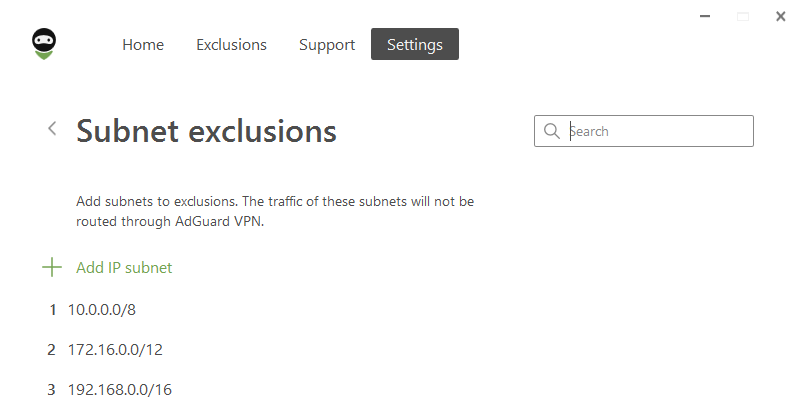
This is to grant ordinary network routes to a specific address in your network, like for a printer. Notably, this should be handled by your network administrator, especially if you aren’t that tech-savvy.
Socks5 Proxy
A proxy gives you a random IP address to interact with others but doesn’t encrypt your network traffic. This also means a faster connection generally since the encryption isn’t there.
In addition, this works on the application level. So, you have to manually set up in each application’s settings to use the Socks5 proxy.
This option resides in the Settings > General > Advanced Settings. Activating this option will set up a local proxy server, and the applications unconfigured will route their traffic normally.
Custom DNS
DNS servers handle the DNS queries. These servers are the address book your computer uses every time you connect to the internet. They convert the pronounceable websites names (ex., mustechie.com) to machine-friendly IP addresses (ex., 125.15.78.14) for the computer to establish a connection.
They see what websites you visit and can log your internet activity. Normally, you don’t need a custom DNS if you’re using a capable privacy-respecting VPN.
But people use custom DNS servers for faster connections, web-filtering, adblocking, phishing protection, etc. However, it undermines the privacy aspect of using a VPN.

Still, if you’re using one and want to continue doing so, head over to Settings > General > DNS Servers. Click +Add custom DNS server, add the IP address, and tap Save and select.
So, this covers some of the features part of this AdGuard VPN review, time to run some tests.
Performance Testing
This section entails some of the essential parameters to test, including speed drops, IP & DNS leaks, and some geo-unblocking.
Speed Tests
Speed used to be the achilles heel of the VPN providers. But recently, the top-tier VPN improved so much you barely notice the ongoing speed throttle.
However, this AdGuard VPN review is based on the free tier, so speed reduction is expected.
Ideally, it’s recommended to use different tools and multiple tests throughout the day to arrive at a reliable average. But even that can vary across days.
So not taking it all too seriously, I’ve used just the Ookla’s speedtest tool with five random locations while testing each server only once.
Here are the results:
| Server | Ping (ms) | Download Speed (Mbps) | Upload Speed (Mbps) | Distance (km) |
| Default | 6 | 49.24 | 44.91 | — |
| New York | 432 | 21.40 | 2.26 | 12,000 |
| Paris | 183 | 11.08 | 1.86 | 6,600 |
| Amsterdam | 291 | 20.66 | 2.62 | 6,400 |
| London | 351 | 4.73 | 1.34 | 6,800 |
| Helsinki | 355 | 20.91 | 2.67 | 5,400 |
The results aren’t anything to be amazed. The ping value is high making the free plan of AdGuard unsuitable for gaming. In addition, there is no balance between the download and upload speed, with the latter struggling a bit too much.
Notably, one important parameter swaying the results can be server load. As of this writing, with AdGuard VPN, there is no possible way to find that while connecting. Though most VPNs never mention this at the interface, ProtonVPN is one such candidate, which shows the server load making it easier to choose between the available ones.
Finally, these results will vary a lot based on your location and the VPN server conditions at the time.
IP, WebRTC & DNS Leaks
An IP address is the first thing to mask for any VPN provider. The IP leaks test conducted with BrowserLeaks confirmed there wasn’t any IP leak.
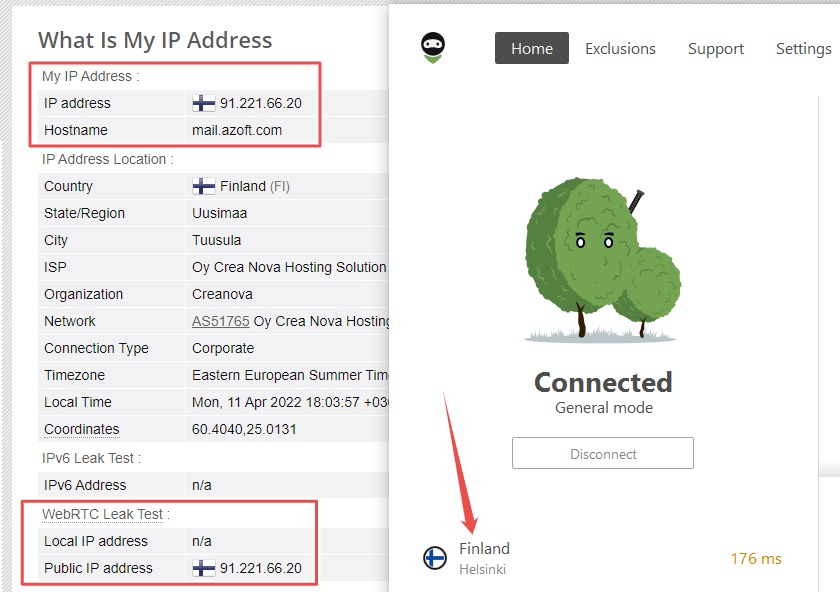
In addition, this test proved AdGuard protects the WebRTC leaks as well. You could be seeing my IP in the Public IP address through the WebRTC leak section had AdGuard left it exposed.
Although AdGuard handled WebRTC leaks, this is a browser-based vulnerability. And a perfectly working VPN could leak your IP address through WebRTC.
If you’re interested, you can fix this for your specific web browser with this guide by restoreprivacy.
Another issue that plagues substandard VPNs are DNS leaks.
DNS leaks happen when your ISP handles your DNS queries even after connecting to a VPN. This is a privacy threat that can result in your ISP knowing everything about your web activity.
So, in addition to the IP & WebRTC leaks, it becomes vital to check your DNS server.
And this can be easily done with the IPleak.
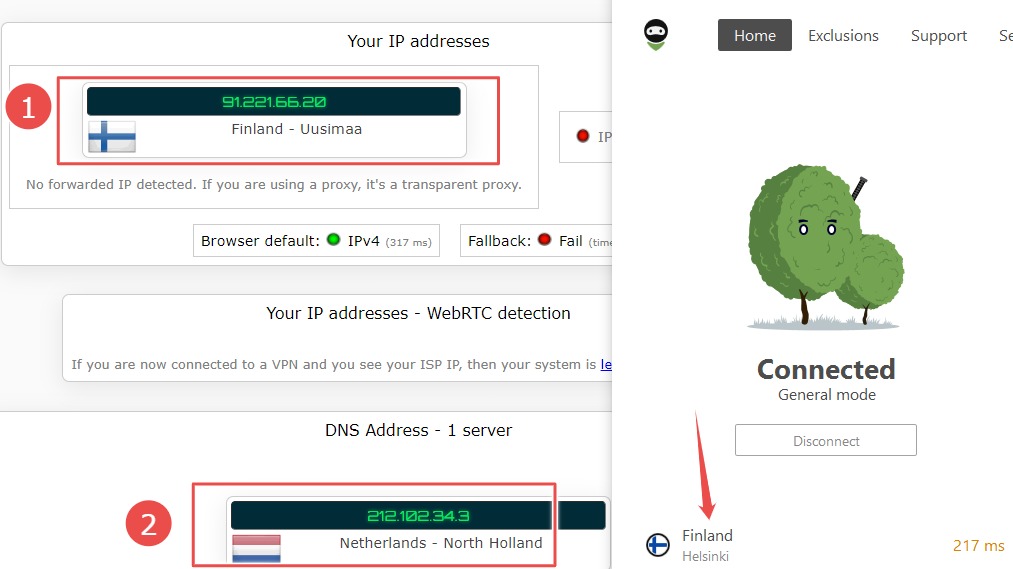
DNS leak test revealed slight mismanagement of DNS queries. This might be okay for privacy, but websites may not load the supposed version based on the VPN server location and may show the version matching the DNS servers.
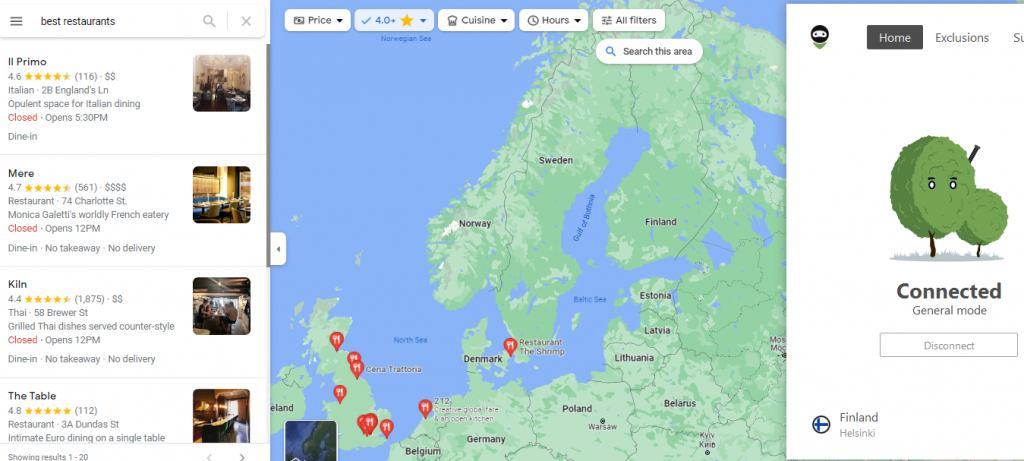
For instance, the best restaurants query in the Google Maps returned no suggestions in the actual server location, Finland. Instead, I could see the results from neighboring countries. Besides, YouTube gave the Russian version and not the regional Finnish.
That’s not a deal-breaker but not an ideal setting, especially if you’ve got paid plans to offer.
Conclusively, AdGuard passed the DNS leak test but query management is the area that needs some work.
Geo-Unblocking (brief)
Frankly, it’s criminal to even hope for a free VPN subscription to unblock streaming platforms.
As these platforms constantly update their firewalls to protect the regional content. Many premium VPNs relentlessly new add IP addresses and deploy efficient unblocking mechanisms to get their user what they need the most.
But surprisingly, the free tier of AdGuard could unblock Amazon Prime US libraries. However, it failed to crack open BBC iPlayer and Hulu.
Though I haven’t tested Netflix, it’s rare for any VPN to falter at Hulu but get success with the strictest streaming platform, Netflix.
Conclusion
AdGuard VPN is a good start which will take time to get matured.
In its present state, it’s really hard to recommend it when you can get a very well-performing SurfShark VPN for the similarly priced annual subscription and get unlimited connections.
Conclusively, AdGuard VPN makes sense primarily if you’re already using their adblocker for better compatibility, or you should stick to its free tier until convinced to pay.
On a side note, check out a completely free, unlimited data, and browser-based VPN: Opera VPN.
